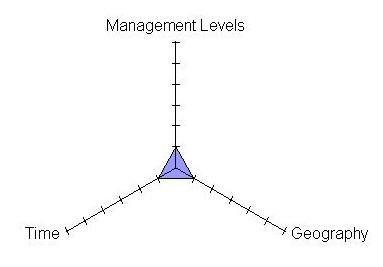Expand Your Collaboration 'Footprint'Expand Your Collaboration 'Footprint'
Use the collaboration footprint method to reveal strengths and weaknesses in how your business shares information.

For most enterprises, successful online collaboration requires massive behavior change across the company. In thinking about how to get many people each to change a little, I borrowed a technique from those who wrestle with a similar predicament: addressing climate change.
We can take many actions to slow climate change, but most of them require millions of people to change their behavior in a coordinated way. So how do you get people out of the "What can I do? I'm just one person" mode of thinking? One small step each person can take is to track his carbon footprint. The goal, of course, is to make your own footprint as small as possible; there are even calculators to help you do it.
Just as your carbon footprint assesses how much carbon dioxide you produce, maybe we need a collaboration footprint to determine how successful we are at working out loud. Our goal, in this case, is not to shrink it, but to make it as large as possible. The key question for each of us to ask is "How visible is my work to other employees? How easy is it for them to find it without my help?" (OK, I guess that's two key questions.)
[It's not just a couple of VPs sharing a cellphone anymore. Read Why Mobility Managers Deserve A Seat At The Table.]
I came up with three dimensions in which we might measure visibility.
Time: If your organization hires someone six months from now and he needs access to information you currently have, how easy is it to find? How easy will it be to find five years from now? How about five years after you've retired?
Space: Sure, other people in your department know what you're doing, but what about the people doing a similar job in another department? In another country? What about the people who are upstream or downstream in a process you manage or execute?
Management chain: No matter how high up in your organization you are, how well do your information, activities, and decisions get communicated to those above or below you?
OK, so what units would we use in each dimension? I came up with six for each, just to make things nice and even.
Time: Today, a week, a month, a year, several years, no limit
Space (or geography): Department, function, site, country, region, global
Management chain (up or down): 0, 1, 2, 3, 4, or 5 or more management levels
Take some time and go back through the content you've created in the last month or so, and measure it along those three dimensions. You can even display those measures as a radar chart to give it that "footprint" look.
The goal should be to make your footprint as large as possible, or at the very least to force yourself to come up with valid business reasons why the score along one or more of the axes should be small. But if you find yourself with one that looks like this, you might ask yourself why.

Are you hoarding valuable information, or is the information you create not worth sharing?
The goal of the collaboration footprint is not necessarily to have a precise metric for collaboration, but to get employees thinking about how (or even if) they are sharing the information and knowledge they create in their jobs. Some information will always need to be tightly held and controlled. Companies often like to err on the side of caution, but what they don't realize is that, more often than not, the hidden cost of employees not having the information necessary to do their jobs outweighs the cost of that information being seen by someone who shouldn't.
Please share any comments about this idea -- positive or negative -- along with any other ideas you might have about other scales you might use to assess collaboration.
The NIST cyber security framework gives critical-infrastructure operators a new tool to assess readiness. But will operators put this voluntary framework to work? Read the Protecting Critical Infrastructure issue of information Government today.
About the Author
You May Also Like






